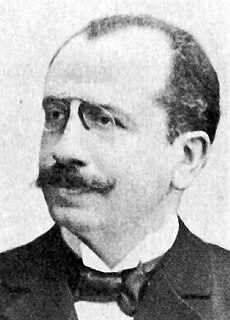See also
- USS U. S. Grant (AP-29), formerly Konig Wilhelm II
Ships named Kaiser Wilhelm II include:

Kaiser Wilhelm der Grosse was a German transatlantic ocean liner named after Wilhelm I, German Emperor, the first monarch of the German Empire.

Albert Ballin was a German shipping magnate. He was the general director of the Hamburg-Amerikanische Packetfahrt-Actien-Gesellschaft (HAPAG) or Hamburg-America Line, which for a time was the world's largest shipping company. Being the inventor of the concept of the cruise ship, he is known as the father of modern cruise ship travel.

The second SS Kaiser Wilhelm II, named for the German Emperor, was a 19,361-gross register ton passenger ship built at Stettin, Germany. The ship was completed in the spring of 1903. The ship was seized by the U.S. Government during World War I, and subsequently served as a transport ship under the name USS Agamemnon. A famous photograph taken by Alfred Stieglitz called The Steerage, as well as descriptions of the conditions of travel in the lowest class, have conflicted with her otherwise glitzy reputation as a high class, high speed trans-Atlantic liner.

The Hamburg-Amerikanische Packetfahrt-Aktien-Gesellschaft (HAPAG), known in English as the Hamburg America Line, was a transatlantic shipping enterprise established in Hamburg, in 1847. Among those involved in its development were prominent citizens such as Albert Ballin, Adolph Godeffroy, Ferdinand Laeisz, Carl Woermann, August Bolten, and others, and its main financial backers were Berenberg Bank and H. J. Merck & Co. It soon developed into the largest German, and at times the world's largest, shipping company, serving the market created by German immigration to the United States and later, immigration from Eastern Europe. On 1 September 1970, after 123 years of independent existence, HAPAG merged with the Bremen-based North German Lloyd to form Hapag-Lloyd AG.

Norddeutscher Lloyd was a German shipping company. It was founded by Hermann Henrich Meier and Eduard Crüsemann in Bremen on 20 February 1857. It developed into one of the most important German shipping companies of the late 19th and early 20th centuries, and was instrumental in the economic development of Bremen and Bremerhaven. On 1 September 1970, the company merged with Hamburg America Line (HAPAG) to form Hapag-Lloyd AG.
Aktien-Gesellschaft Vulcan Stettin was a German shipbuilding and locomotive building company. Founded in 1851, it was located near the former eastern German city of Stettin, today Polish Szczecin. Because of the limited facilities in Stettin, in 1907 an additional yard was built in Hamburg. The now named Vulcan-Werke Hamburg und Stettin Actiengesellschaft constructed some of the most famous civilian German ships and it played a significant role in both World Wars, building warships for the Kaiserliche Marine and the Kriegsmarine later.
SS America may refer to:

SS Deutschland was a passenger liner built in Stettin and launched in 1900 by the Hamburg America Line of Germany. The rival North German Lloyd line had launched Germany's first four funnel liner, Kaiser Wilhelm der Grosse in 1897, and SS Deutschland was built by Hamburg America as Germany's second four-funnel liner in order to compete.

SS Kronprinzessin Cecilie was an ocean liner built in Stettin, Germany, in 1906 for North German Lloyd that had the largest steam reciprocating machinery ever fitted to a ship. The last of four ships of the Kaiser class, she was also the last German ship to have been built with four funnels. She was engaged in transatlantic service between her homeport of Bremen and New York until the outbreak of World War I.

SS Saale was an ocean liner for North German Lloyd in the late 19th century, which was severely damaged in the 1900 Hoboken Docks Fire. On 30 June 1900, Saale was moored at the North German Lloyd piers in Hoboken, New Jersey, preparing to depart on a transatlantic crossing when some cotton on a nearby pier caught on fire and spread to the ship. Saale and several other ships were soon engulfed in flames; 99 passengers and crew on Saale were killed in the fire and subsequent sinking.
SS Scharnhorst may refer to one of the following passenger steamers for North German Lloyd:
SS City of Honolulu may refer to one of these Los Angeles Steamship Company ships:
SS Köln may refer to one of the following passenger steamers for North German Lloyd:
SS Potsdam may refer to:
SS Neckar may refer to one of the following North German Lloyd passenger steamers:

The Kaiser-class ocean liners or Kaiserklasse refer to four transatlantic ocean liners of the Norddeutscher Lloyd, a German shipping company. Built by the AG Vulcan Stettin between 1897 and 1907, these ships were designed to be among the largest and best appointed liners of their day. These four ships, two of which held the prestigious Blue Riband, were known as the "four flyers" and all proved to be popular with wealthy transatlantic travellers. They also took great advantage of the masses of immigrants who wished to leave Europe.

SS Burdigala was an ocean liner that sailed the Atlantic Ocean from 1898 until World War I. The ship was built as the Kaiser Friedrich in 1898 for Norddeutscher Lloyd (NDL), a German shipping line. Designed to break the speed record for a transatlantic liner and thereby win the Blue Riband, the Kaiser Friedrich never achieved the necessary speeds. After a short career with NDL and an equally short period of service with NDL's main German competitor, the Hamburg-Amerikanische Packetfahrt-Aktien-Gesellschaft, the ship was mothballed for a decade. After being sold to the French shipping line Compagnie de Navigation Sud-Atlantique, it re-entered service as SS Burdigala. In 1916, while en route from Thessaloniki to Toulon, the liner struck a mine laid by the German U-boat U-73 in the Aegean Sea and sank near Kea, Greece.